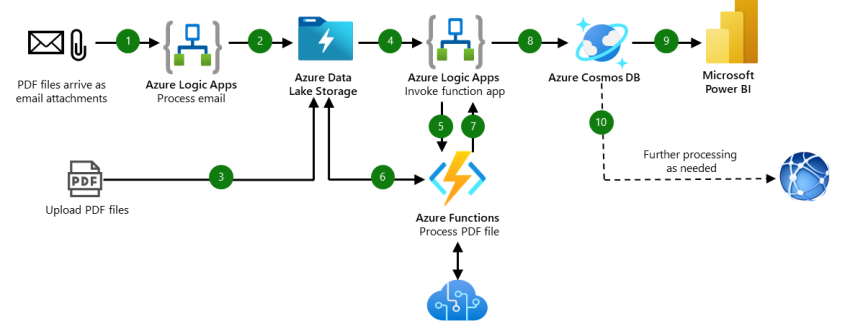Automating Retail Order Processing with Azure Functions
Azure Functions is a serverless compute service that enables businesses to run small pieces of code, called functions, without managing infrastructure. This is especially useful for tasks that are event-driven, require scalability, and must operate with minimal overhead. In this blog, we’ll explore a real-time example of Azure Functions implemented for a retail client to automate their order processing system, demonstrating how this serverless approach transformed their business operations.
Client Overview
Client: A Global E-Commerce Retailer
Our client is a rapidly growing e-commerce retailer managing thousands of daily transactions. With customers across multiple time zones, they required a highly scalable, real-time system to automate order processing, including:
- Validating order details
- Sending confirmation emails
- Updating inventory
- Notifying logistics for shipment
Challenges:
- High Traffic Volumes: The client experienced traffic spikes during promotions, making it essential to scale operations quickly.
- Manual Processes: Order processing involved manual validation and communication, leading to delays.
- Cost Efficiency: The client wanted to avoid maintaining dedicated infrastructure for processes that were only active during peak hours.
Solution: Azure Functions-Based Serverless Architecture
To address these challenges, we implemented a serverless order processing system using Azure Functions. This event-driven approach automated the entire order lifecycle, from receiving the order to updating the inventory.
Architecture Overview
- Event Source: Orders were placed through the client’s e-commerce platform and stored in an Azure SQL database.
- Trigger: Azure Functions was configured to trigger upon new entries in the database or messages in the Azure Service Bus queue.
- Processing: Functions were responsible for validating orders, sending notifications, and updating inventory.
- Output: Processed data was stored in the database, and updates were sent to external APIs for logistics and inventory systems.
Key Components of the Solution
1. Triggering the Function
We used Azure Service Bus as the trigger mechanism for Azure Functions. Whenever a new order was placed, it was pushed into the Service Bus queue. This ensured:
- High reliability for event delivery.
- The ability to handle high traffic volumes during promotions.
Code Example (Service Bus Trigger in Azure Functions):
public static class OrderProcessorFunction
{
[FunctionName(“ProcessOrder”)]
public static async Task Run(
[ServiceBusTrigger(“ordersqueue”, Connection = “ServiceBusConnection”)] string orderMessage,
ILogger log)
{
log.LogInformation($”Processing new order: {orderMessage}”);
// Process the order
}
}
2. Order Validation
The function validated order details to ensure:
- Correct product IDs and availability.
- Payment confirmation.
- Accurate customer information.
Implementation:
- Integrated with an external payment gateway API to confirm payments.
- Queried the Azure SQL database to validate product availability.
3. Sending Notifications
Upon successful validation, the function triggered notifications:
- Order Confirmation Emails: Sent to customers using SendGrid API.
- Logistics Notifications: Notified shipping teams about the order.
Code Example (SendGrid Integration for Email):
public static async Task SendConfirmationEmail(string customerEmail, string orderId)
{
var apiKey = Environment.GetEnvironmentVariable(“SendGridApiKey”);
var client = new SendGridClient(apiKey);
var message = new SendGridMessage
{
From = new EmailAddress(“orders@retailclient.com”, “Retail Client”),
Subject = $”Order Confirmation – {orderId}”,
HtmlContent = “<strong>Your order has been confirmed!</strong>”
};
message.AddTo(customerEmail);
await client.SendEmailAsync(message);
}
4. Inventory Updates
Azure Functions updated the inventory in real-time by:
- Subtracting purchased quantities from stock levels.
- Sending alerts for low-stock items via another function.
Code Example (Inventory Update):
public static async Task UpdateInventory(string productId, int quantitySold)
{
string connectionString = Environment.GetEnvironmentVariable(“SqlConnection”);
using (SqlConnection conn = new SqlConnection(connectionString))
{
await conn.OpenAsync();
var command = new SqlCommand(
“UPDATE Inventory SET Quantity = Quantity – @quantity WHERE ProductID = @productId”, conn);
command.Parameters.AddWithValue(“@quantity”, quantitySold);
command.Parameters.AddWithValue(“@productId”, productId);
await command.ExecuteNonQueryAsync();
}
}
5. Scalability and Cost Efficiency
Scaling:
Azure Functions automatically scaled to handle traffic spikes, such as during Black Friday sales. For example:
- During low traffic, only a few instances ran, minimizing costs.
- During peak traffic, the function scaled to process thousands of orders simultaneously.
Cost Efficiency:
The pay-as-you-go model ensured the client only paid for execution time, avoiding unnecessary infrastructure costs.
Business Impact
1. Automated Order Processing
By leveraging Azure Functions, the client automated 95% of their order processing tasks, reducing manual effort and processing time.
2. Real-Time Notifications
Customers received instant order confirmations, improving customer satisfaction. Similarly, logistics teams were notified immediately, ensuring faster order fulfillment.
3. Improved Scalability
The system handled traffic spikes effortlessly during promotional events, maintaining performance and reliability.
4. Cost Savings
Compared to the previous setup with dedicated infrastructure, the serverless architecture reduced operational costs by 40%.
5. Enhanced Reporting
The data processed by Azure Functions was pushed to a Power BI dashboard, providing the client with real-time insights into sales, inventory, and customer behavior.


Leave a Reply
Want to join the discussion?Feel free to contribute!